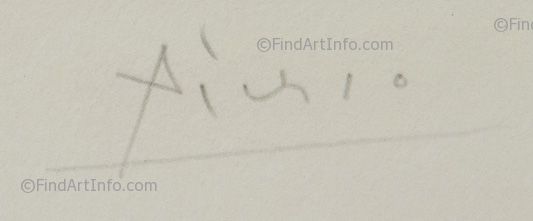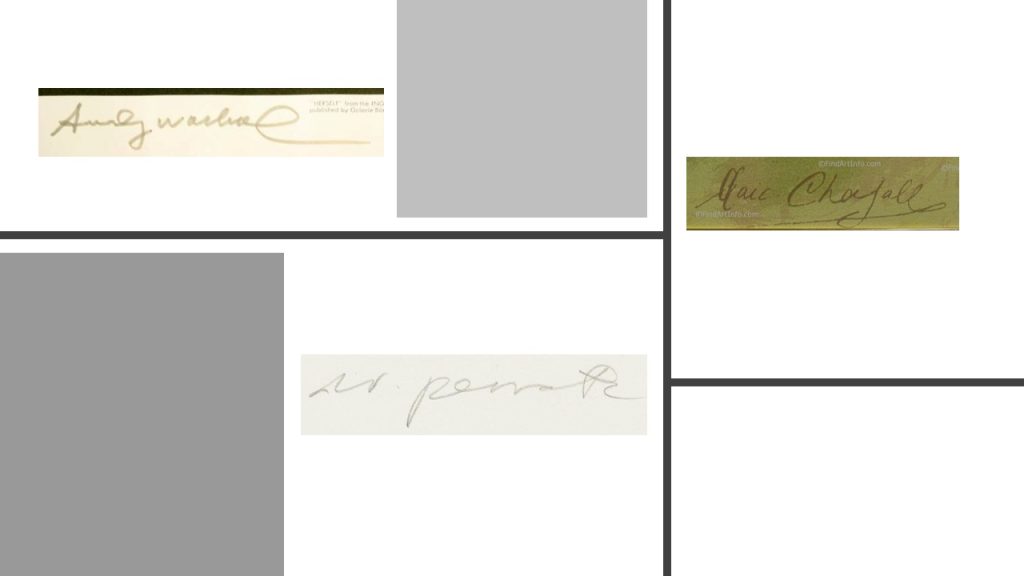How to identify an Artist Signature? Have you ever stood before a mesmerizing painting, caught in the swirl of colors and strokes, only to be left wondering about the genius behind the masterpiece? Fear not, fellow art enthusiasts! The answer may be concealed in plain sight—within the artist’s signature. In this exploration, we embark on a fascinating journey into the world of deciphering artist signatures, understanding their historical significance, and unveiling the methods to identify and authenticate these subtle yet potent marks.
Table of Contents
The Renaissance and the Birth of Signatures
 The tradition of artists signing their work is a practice that traces its roots back to the Renaissance, a transformative period marked by a flourishing of creativity and individualism. Visionaries such as Leonardo da Vinci and Michelangelo began the practice of signing their pieces, a departure from the anonymity that shrouded much of medieval art. The artist’s signature became more than a mere identification; it evolved into a symbol of artistic identity and pride.
The tradition of artists signing their work is a practice that traces its roots back to the Renaissance, a transformative period marked by a flourishing of creativity and individualism. Visionaries such as Leonardo da Vinci and Michelangelo began the practice of signing their pieces, a departure from the anonymity that shrouded much of medieval art. The artist’s signature became more than a mere identification; it evolved into a symbol of artistic identity and pride.
Fast forward to the contemporary art scene, and artist signatures have become a critical aspect of the art world. No longer just a mere scribble on canvas, the act of signing a work carries profound significance, reflecting the artist’s personal connection with their creation. The process involves meticulous consideration of placement, style, and even changes over an artist’s career, creating a signature that acts as a distinctive identifier and a chronological map of their artistic journey.
Signatures as Time Capsules
Delving deeper into the realm of artistic signatures reveals another layer of intrigue – they serve as time capsules, encapsulating valuable clues about when a particular piece was crafted. Artists, in their evolution and growth, often alter their signatures over the years, leaving behind a trail of chronological breadcrumbs for art enthusiasts and historians.

![]() Take, for instance, the iconic Pablo Picasso. The evolution of his signature, from the early elegant and formal script to the later abstract and fluid forms, not only mirrors his artistic metamorphosis but also provides a timeline for enthusiasts to trace his creative journey. Another captivating example is the renowned artist Marc Chagall. By examining the subtle changes in his signature from the 1910s to the 1970s, one can gain insights into the shifting landscape of his artistic style and the historical context of each creation.
Take, for instance, the iconic Pablo Picasso. The evolution of his signature, from the early elegant and formal script to the later abstract and fluid forms, not only mirrors his artistic metamorphosis but also provides a timeline for enthusiasts to trace his creative journey. Another captivating example is the renowned artist Marc Chagall. By examining the subtle changes in his signature from the 1910s to the 1970s, one can gain insights into the shifting landscape of his artistic style and the historical context of each creation.
The Invisible Signature: When Less is More
However, not all artists leave visible signatures. Some opt for subtlety, incorporating their initials or a discreet symbol directly into the artwork. This adds an extra layer of challenge for art detectives, demanding a keen eye and a touch of intuition to unveil the hidden marks within a piece.
One artist who exemplifies this enigmatic approach is Banksy, the anonymous street artist known for politically charged and thought-provoking works. Banksy’s deliberate choice to forego a traditional, overt signature has sparked global intrigue. The quest to unravel the mystery behind Banksy’s identity has become an art form in itself, with enthusiasts and scholars scrutinizing every detail in a perpetual attempt to decode the elusive artist’s mark.
Good Intentions, False Signatures
The journey into the realm of artist signatures encounters a twist with the emergence of false signatures, often borne out of good intentions. The passage of time or the diligent efforts of art restorers can lead to the erosion or obliteration of an original signature. In an earnest endeavor to preserve the artist’s legacy, well-meaning restorers or owners may add a replacement signature. However, despite the noble intentions, these interventions can inadvertently mislead collectors and enthusiasts, highlighting the delicate balance between preservation and authenticity.
To navigate this nuanced landscape and avoid falling victim to well-intentioned deceptions, it becomes imperative for art enthusiasts to educate themselves on how to spot a fake signature.
Deciphering the Authentic from the Imitation
Spotting a fake signature demands a discerning eye and a bit of detective work. Here are some essential tips to help enthusiasts separate the authentic from the imitation:
- Consistency is Key: Authentic artist signatures exhibit remarkable consistency. By familiarizing oneself with an artist’s typical signature style – paying attention to the flow, size, and spacing of letters – enthusiasts can develop a critical eye for spotting irregularities.
- Anachronisms and Anomalies: Researching an artist’s known signatures from different periods is crucial. If a signature deviates from the artist’s typical style or fails to align with their known timeline, it serves as a red flag, signaling potential falsification.
- Consult the Experts: Leveraging online resources and databases dedicated to art authentication is a powerful tool. Platforms such as FindArtInfo offer extensive databases of artist signatures, providing enthusiasts with a valuable reference point for cross-referencing signatures and gaining insights into an artist’s body of work.
- Documentation and Provenance: Verifying the provenance and documentation of the artwork is a critical step. A well-documented history, including exhibition records and certificates of authenticity, adds significant credibility to the artist’s signature.
- Seek Professional Opinion: When in doubt, seeking the expertise of professionals is paramount. Art appraisers and authentication experts possess the experience and knowledge to provide valuable insights into the legitimacy of a signature, offering a layer of assurance for enthusiasts navigating the intricate landscape of artist signatures.
Signatures: Important, but Not Essential
While artist signatures undeniably hold significant value in the realm of art, it’s essential to acknowledge that their absence does not diminish the worth of a piece. The authenticity and value of artwork are influenced by a myriad of factors, including provenance, condition, and the artist’s reputation.
An illuminating example of this principle can be found in the work of Jackson Pollock, particularly his iconic drip paintings. Pollock, known for his revolutionary technique, rarely signed these works on the front, opting instead to sign on the back or, in some cases, not at all. The absence of a visible signature does not detract from the cultural and artistic impact of these masterpieces, underscoring the multifaceted nature of artistic value.
How to Identify an Artist Signature
Identifying an artist’s signature is a thrilling yet challenging endeavor that requires a systematic approach. Here’s a step-by-step guide to help art enthusiasts unlock the secrets hidden within the strokes of a signature:
1. Research the Artist
Begin by delving into the artist’s body of work. Familiarize yourself with their signature style, paying careful attention to unique flourishes or distinctive letter formations that set their mark apart.
2. Utilize Online Resources
Leverage the power of online databases and resources dedicated to art authentication. Websites like FindArtInfo.com offer extensive databases of artist signatures, providing enthusiasts with a valuable tool for comparison and verification.
3. Connect with the Art Community
Engage with the art community both online and in person. Forums, social media groups, and local art events can serve as valuable sources of information and insights. Sharing images of the signature and seeking input from fellow enthusiasts can provide a fresh perspective.
4. Visit Art Galleries and Museums
Explore local art galleries and museums to witness authenticated works by the artist in question. Studying genuine signatures in person can significantly enhance an enthusiast’s ability to identify them in different contexts.
5. Consult Experts
In cases of uncertainty, seek the opinion of art experts and appraisers. Professionals with experience in art authentication can provide invaluable guidance and confirmation, offering a layer of expertise to complement an enthusiast’s efforts.
Read more Painting Signature: 7 Ways to Unlock the Amazed Hidden
FAQs
Why do artists sign their work?
Artists sign their work as a symbol of artistic identity and pride. The tradition originated in the Renaissance, marking a departure from the anonymity of medieval art. Today, an artist’s signature is a personal connection with their creation, reflecting their identity and pride in their work.
How can an artist’s signature act as a time capsule?
Signatures evolve over an artist’s career, providing a chronological map of their artistic journey. Artists often alter their signatures, offering valuable clues about when a piece was created. Examining the evolution of a signature can reveal insights into an artist’s growth and changing style.
Why do some artists opt for invisible signatures?
Some artists choose subtlety, incorporating initials or discreet symbols, adding an air of mystery to their work. Banksy, the anonymous street artist, is a prime example. His lack of a traditional signature sparks global intrigue, turning the quest to unveil his identity into an art form.
What are false signatures, and how do they emerge?
False signatures can result from restoration efforts or the erosion of original signatures over time. Well-intentioned restorers or owners may add replacement signatures to preserve an artist’s legacy. However, these interventions can unintentionally mislead collectors, emphasizing the delicate balance between preservation and authenticity.
How can I spot a fake artist signature?
Consistency, researching known signatures, consulting experts, verifying documentation, and seeking professional opinions are key. Recognizing irregularities, anachronisms, and anomalies in a signature requires a discerning eye. Online resources like FindArtInfo.com can be invaluable, as can verification through documentation and expert opinions.
Do artist signatures determine a piece’s value?
While important, the absence of a signature doesn’t diminish a piece’s worth; factors like provenance, condition, and the artist’s reputation also contribute. Using Jackson Pollock’s drip paintings as an example, their cultural and artistic impact remains significant, even with Pollock’s rare practice of not signing them on the front.


It’s a shame you don’t have a donate button! I’d without a
doubt donate to this brilliant blog! I suppose for now i’ll settle for book-marking and adding your RSS feed to
my Google account. I look forward to new updates
and will share this site with my Facebook group. Chat soon! You can see similar:
sklep internetowy and here
sklep online
Wow, awesome weblog structure! How lengthy
have you been running a blog for? you make running a blog
glance easy. The full look of your website is great, as neatly as the content!
You can see similar: sklep internetowy and here sklep internetowy
What necessary words… super, magnificent idea
It’s really a cool and helpful piece of info.
I am sqtisfied that you simply shared this useful information with us.
Plrase keep us informed like this. Thank you ffor
sharing. https://Www.waste-ndc.pro/community/profile/tressa79906983/